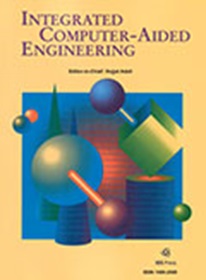铸造缺陷的谱域实例分割模型
IF 5.3
2区 计算机科学
Q1 COMPUTER SCIENCE, ARTIFICIAL INTELLIGENCE
引用次数: 4
摘要
铸件缺陷的准确分割对铸件产品的质量控制起着积极的作用,对铸件凝固过程中缺陷的力学性能的准确提取具有重要意义。然而,由于铸件缺陷形状复杂、不规则,现有的分割方法对铸件缺陷进行分割具有一定的挑战性。为了解决这一问题,提出了一种谱域实例分割模型(SISN),对五种形状复杂的铸造缺陷进行精确分割。五种缺陷是夹杂、收缩、热撕裂、冷撕裂和微孔。该模型包括三个子模型:频谱域区域建议模型(SRPN)、频谱域兴趣区域对齐模型(SRoIAlign)和频谱域实例生成模型(SIGN)。SRPN采用多尺度锚定机制检测各种尺寸的缺陷,其中利用SSReLU和SCPool函数解决了谱域梯度爆炸问题和谱域过拟合问题。SRoIAlign使用浮点量化运算和三线性插值方法将三维建议精确量化到特征值。SIGN是一种应用于3D提案的全谱域神经网络,以逐点的方式生成缺陷的分割实例。在实验中,我们从分割精度、时间性能和力学性能提取精度三个方面验证了所提模型的有效性。本文章由计算机程序翻译,如有差异,请以英文原文为准。
A spectrum-domain instance segmentation model for casting defects
Accurate segmentation of casting defects plays a positive role in the quality control of casting products, and is of great significance for accurate extraction of the mechanical properties of defects in the casting solidification process. However, as the shape of casting defects is complex and irregular, it is challenging to segment casting defects by existing segmentation methods. To address this, a spectrum domain instance segmentation model (SISN) is proposed for segmenting five types of casting defects with complex shapes accurately. The five defects are inclusion, shrinkage, hot tearing, cold tearing and micro pore. The proposed model consists of three sub-models: the spectrum domain region proposal model (SRPN), spectrum domain region of interest alignment model (SRoIAlign) and spectrum domain instance generation model (SIGN). SRPN uses a multi-scale anchoring mechanism to detect defects of various sizes, where the SSReLU and SCPool functions are used to solve the spectrum domain gradient explosion problem and the spectrum domain over-fitting problem. SRoIAlign uses the floating-point quantization operation and the tri-linear interpolation method to quantize the 3D proposals to the feature values in an accurate manner. SIGN is a full-spectrum domain neural network applied to 3D proposals, generating a segmentation instance of defects in a point-wise manner. In the experiments, we test the effectiveness of the proposed model from three aspects: segmentation accuracy, time performance and mechanical property extraction accuracy.
求助全文
通过发布文献求助,成功后即可免费获取论文全文。
去求助
来源期刊

Integrated Computer-Aided Engineering
工程技术-工程:综合
CiteScore
9.90
自引率
21.50%
发文量
21
审稿时长
>12 weeks
期刊介绍:
Integrated Computer-Aided Engineering (ICAE) was founded in 1993. "Based on the premise that interdisciplinary thinking and synergistic collaboration of disciplines can solve complex problems, open new frontiers, and lead to true innovations and breakthroughs, the cornerstone of industrial competitiveness and advancement of the society" as noted in the inaugural issue of the journal.
The focus of ICAE is the integration of leading edge and emerging computer and information technologies for innovative solution of engineering problems. The journal fosters interdisciplinary research and presents a unique forum for innovative computer-aided engineering. It also publishes novel industrial applications of CAE, thus helping to bring new computational paradigms from research labs and classrooms to reality. Areas covered by the journal include (but are not limited to) artificial intelligence, advanced signal processing, biologically inspired computing, cognitive modeling, concurrent engineering, database management, distributed computing, evolutionary computing, fuzzy logic, genetic algorithms, geometric modeling, intelligent and adaptive systems, internet-based technologies, knowledge discovery and engineering, machine learning, mechatronics, mobile computing, multimedia technologies, networking, neural network computing, object-oriented systems, optimization and search, parallel processing, robotics virtual reality, and visualization techniques.
 求助内容:
求助内容: 应助结果提醒方式:
应助结果提醒方式:


